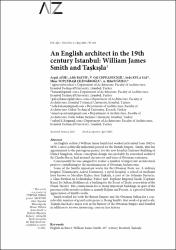| dc.contributor.author | Ağır, Aygül | |
| dc.contributor.author | Batur, Afife | |
| dc.contributor.author | Cephanecigil, V. Gül | |
| dc.contributor.author | Say, Seda Kula | |
| dc.contributor.author | Çilingiroğlu, Mine Topçubaşı | |
| dc.contributor.author | Uğurlu, A.Hilal | |
| dc.date.accessioned | 2021-07-29T08:50:50Z | |
| dc.date.available | 2021-07-29T08:50:50Z | |
| dc.date.issued | 2015 | en_US |
| dc.identifier.citation | AĞIR, Aygül, Afife BATUR, V. Gül CEPHANECİGİL, Seda KULA SAY, Mine Topçubaşı ÇİLİNGİROĞLU & A. Hilal UĞURLU. "An English Architect in the 19th Century Istanbul: William James Smith and Taşkışla". A/Z ITU Journal of the Faculty of Architecture, 12.2 (2015): 93-101. | en_US |
| dc.identifier.uri | https://www.az.itu.edu.tr/azvol12no2web/11-Agir-Batur-Cephanecigil-Say-1202.pdf | |
| dc.identifier.uri | https://hdl.handle.net/11352/3780 | |
| dc.description.abstract | An English architect William James Smith had worked in Istanbul from 1842 to
1856, a most politically influential period for the British Empire. Smith, after his
appointment to the prestigious project for the new Istanbul Embassy Building of
United Kingdom, whose conceptual design was probably by renowned architect
Sir Charles Barry, had attained the interest and trust of Ottoman statesmen.
Consequently he was assigned to realise a number of important architectural
projects contributing to the modernization of Ottoman Architecture.
Some of the Smith’s important works for the Ottoman Porte are: A military
hospital [Gümüşsuyu Askeri Hastanesi], a naval hospital, a school of medicine
later known as Mecidiye Kışlası then Taşkışla, a part of the Selimiye Barracks,
a Glass Pavilion in Dolmabahçe Palace and Tophane Imperial Kiosk [Tophane
Kasrı] for Sultan Abdülmecid; a building for the Board of Trade, renovation of the
Naum Theatre. His commissions for so many important buildings, in spite of the
presence of the notable architects, namely Balyan and Fossati, is a proof of Sultan’s
appreciation of Smith’s works.
Smith worked for both the British Empire and the Ottoman Sultan for a considerable
number of grand scale projects. Being Smith’s first work of grand scale,
Taşkışla has had a major role in the history of the Ottoman Empire and Istanbul
in addition to its own interesting construction history. | en_US |
| dc.language.iso | eng | en_US |
| dc.publisher | İstanbul Teknik Üniversitesi | en_US |
| dc.rights | info:eu-repo/semantics/openAccess | en_US |
| dc.subject | English Architect | en_US |
| dc.subject | William James Smith | en_US |
| dc.subject | 19th Century | en_US |
| dc.subject | İstanbul | en_US |
| dc.subject | Taşkışla | en_US |
| dc.title | An English Architect in the 19th Century Istanbul: William James Smith and Taşkışla | en_US |
| dc.type | article | en_US |
| dc.relation.journal | A/Z ITU Journal of the Faculty of Architecture | en_US |
| dc.contributor.department | FSM Vakıf Üniversitesi, Mimarlık ve Tasarım Fakültesi, Mimarlık Bölümü | en_US |
| dc.identifier.volume | 12 | en_US |
| dc.identifier.issue | 2 | en_US |
| dc.identifier.startpage | 93 | en_US |
| dc.identifier.endpage | 101 | en_US |
| dc.relation.publicationcategory | Makale - Uluslararası Hakemli Dergi - Kurum Öğretim Elemanı | en_US |
| dc.contributor.institutionauthor | Çilingiroğlu, Mine Topçubaşı | |



















